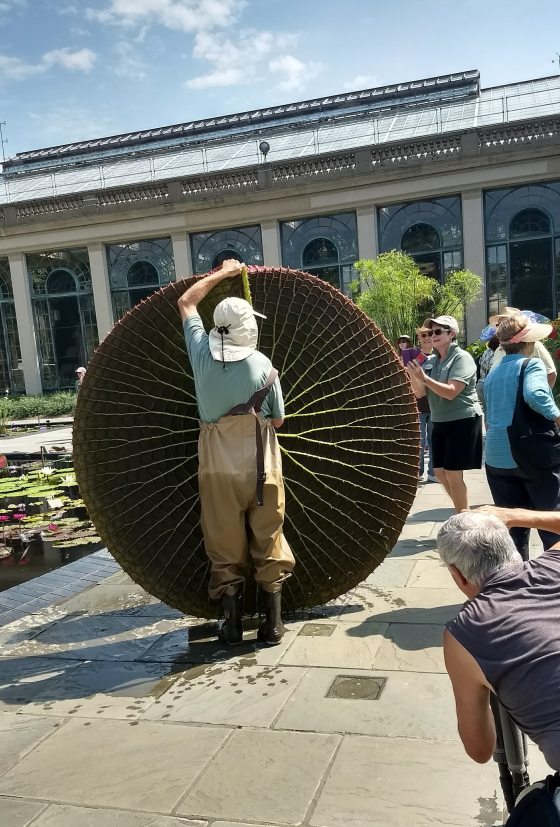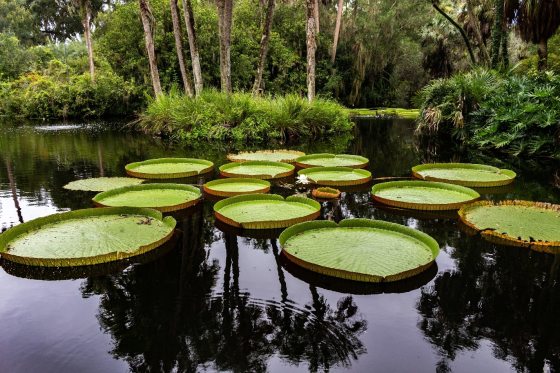Education and the sharing of knowledge take on many forms at Longwood. Sometimes, as in the case of distributing the seed of our spectacular water-platters (Victoria spp.), our most far-reaching educational experiences start with a seed sent to gardens around the world … resulting in not only the sharing of seed that is not readily available commercially, but allowing for even more public garden visitors worldwide to experience the beauty of Victoria.

First observed by Europeans in South America in the early 1800s, Victoria spp., commonly known as water-platters, have fascinated professional horticulturists to hobbyist gardeners alike … and since the late 1800s these unique aquatic plants have amazed visitors to public gardens around the world. Steeped in folklore and often recognized by their sheer size, water-platters are the perfect plant to inspire public garden guests to think about the vast diversity of plants and our natural environments on Earth.

Longwood Gardens is a leader in the field of growing and displaying water-platters in a public garden setting. Beginning in the 1950s, Longwood began growing Victoria amazonica, native to Guyana and the Amazon River basin, and Victoria cruziana, native to the Parana River in northern Argentina, Paraguay, and Bolivia. A hybrid cross between Victoria amazonica and Victoria cruziana called 'Longwood Hybrid' was developed at Longwood Gardens by Water Lily Hall of Fame inductee and Longwood staff member Patrick Nutt in 1960, and first flowered at Longwood Gardens in 1961.
This hybrid water-platter surpassed its parents with respect to its vigor, flower and leaf size, ornamental attributes, and cold tolerance. A single leaf of Victoria ‘Longwood Hybrid’ can reach 8 feet (2.5 meters) in diameter. This cross has been repeated every summer since 1960 and new plants are started from seeds indoors each mid-January to go on display for public viewing starting in late May.

It all begins with a seed and a single water-platter plant can produce hundreds of seed. For decades, to support capacity building and Victoria conservation, Longwood Gardens distributed its surplus seed to public gardens around the world, including the Missouri Botanic Garden and the Royal Botanic Gardens, Kew, who happened to be some of the first gardens to display Victoria to the general public. These garden recipients, plus dozens more, have been able to germinate Longwood’s seed, which is not readily available commercially, and display and interpret these awe-inspiring plants. Longwood’s educational reach then widens, inspiring a global community of learners and memory-making. Patrick Lynch, Plant Records Curator at Bok Tower Gardens in Lake Wales, Florida shares that “these plants are one of our most popular summer attractions.”

Longwood has also long supported the work of the International Waterlily & Water Gardening Society, as “the genus Victoria is of special interest to the IWGS because of its uniqueness and use by botanic gardens and public institutions in capturing public interest in aquatic plants.” In a newer initiative started in 2018, Longwood now distributes large quantities of water-platter seed to the society for distribution amongst its members. This distribution allows Longwood to both support the widespread education of this amazing plant and to get our seed to more individuals, thereby sharing our intellectual capital.

The next time you are visiting a public garden or here at Longwood visiting our Waterlily Display and are lucky enough to see a water-platter growing, think about the wondrous diversity of plants on Earth … and the sharing behind that diversity. Learn more about Victoria and how this waterlily queen is woven into our history in this fascinating online exhibit.


